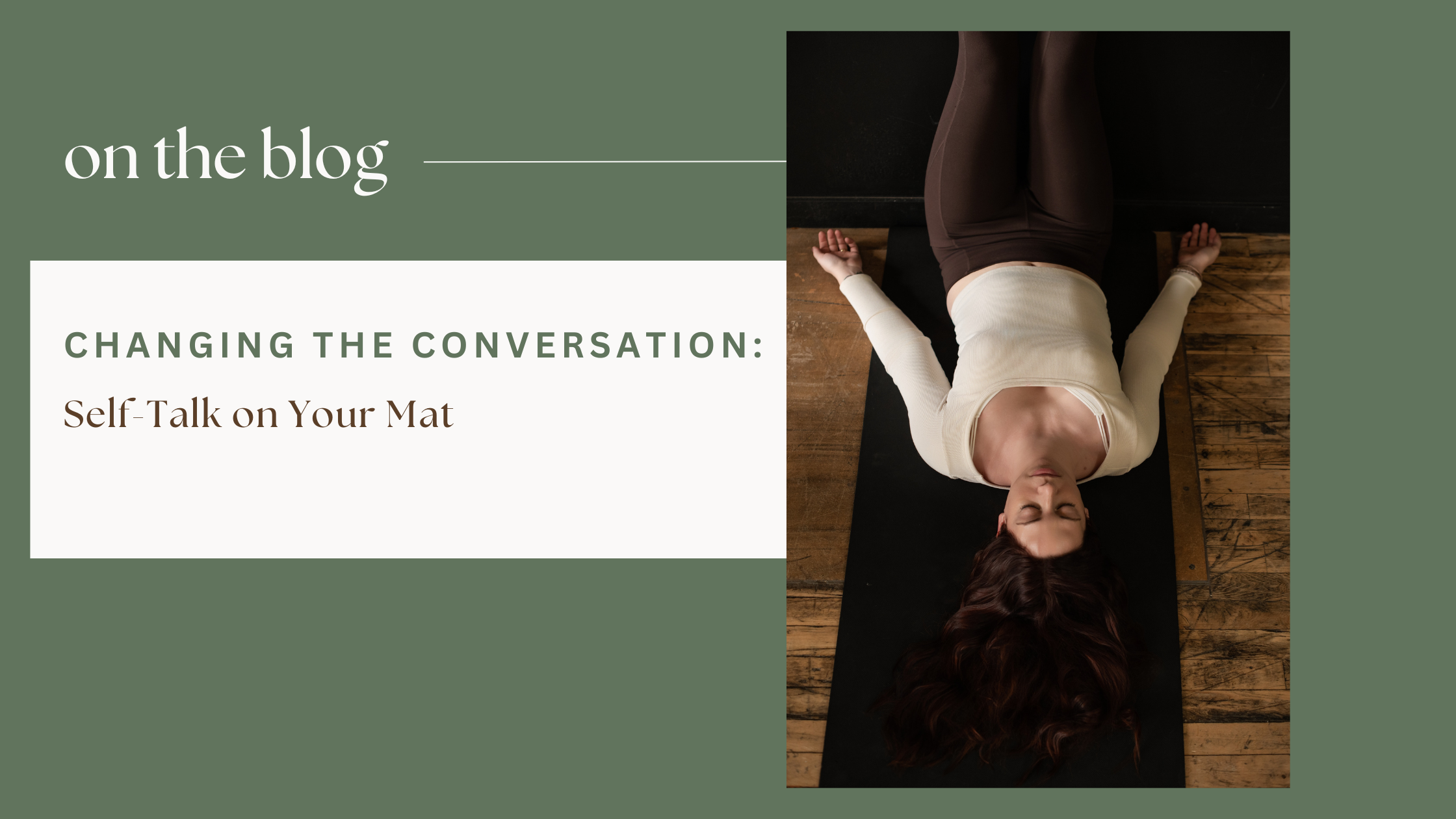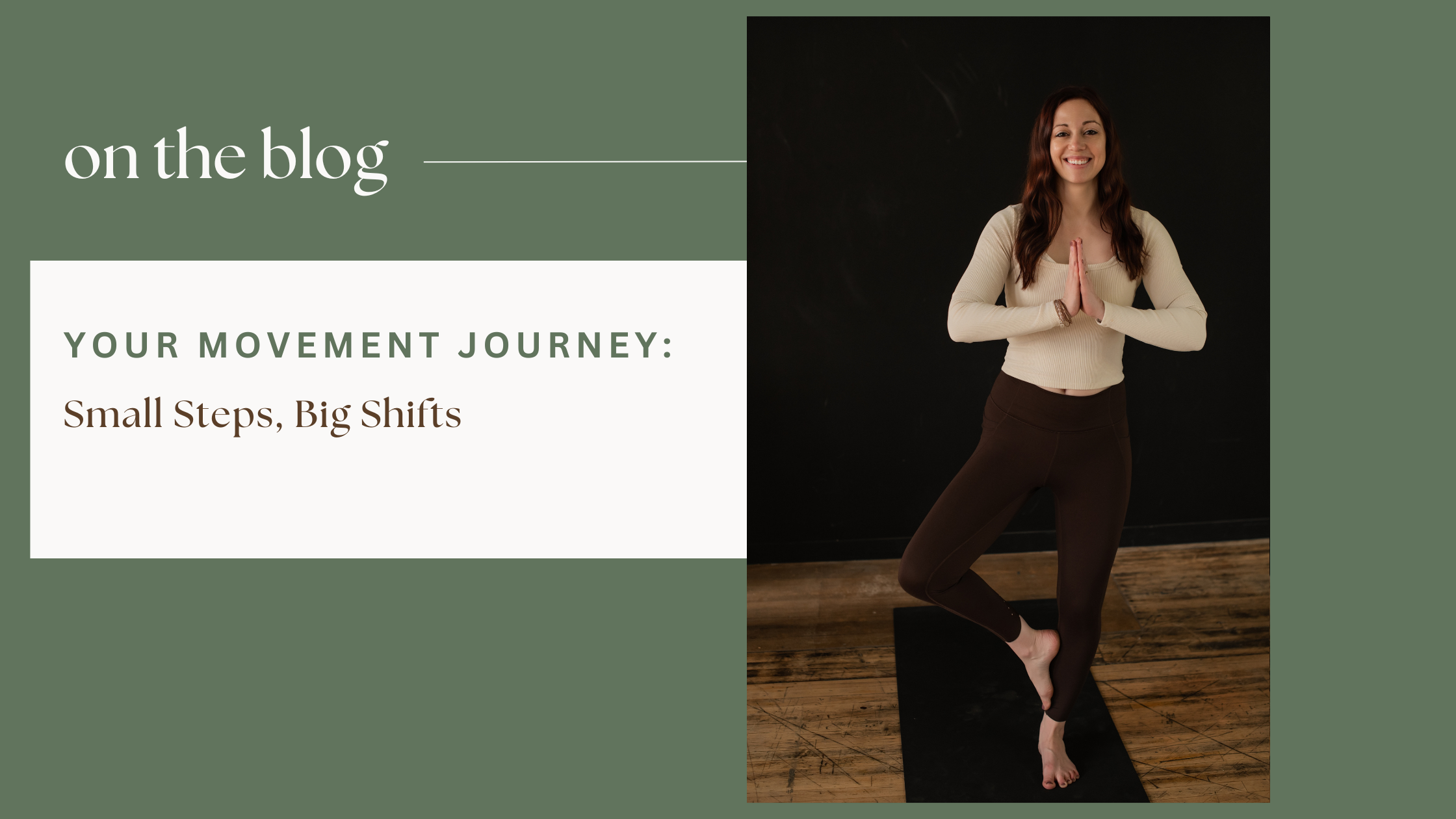Where we explore the beautiful, messy, and meaningful journey of caring for yourself - through movement, celebration, and moments.
Nurture Studios
Changing the Conversation: Self-Talk on Your Mat
You know that voice - the one that shows up the moment you step onto your mat. It might whisper things like "You should be able to do this by now" or "Everyone else looks so much more graceful." Maybe it gets louder when you need to rest, when you wobble, or when yesterday's easy pose feels impossible today.
Here's what I want you to know: that inner conversation happening during your practice? It's just as important as any pose you'll ever attempt. And just like your physical practice, it can be cultivated with patience, awareness, and a whole lot of compassion.
The way we speak to ourselves on the mat often reflects how we speak to ourselves everywhere else. So when we practice shifting that inner dialogue during yoga, we're actually training for life.
1. Notice Before You Judge (The Gentle Pause)
The first step isn't to stop the critical thoughts - that's asking too much and often makes them louder. Instead, we're going to practice noticing them before they spiral.
Here's how:
The moment you catch yourself in negative self-talk ("I'm so inflexible," "I'm the worst at balancing," "I shouldn't need to modify"), pause. Don't fight the thought. Don't judge yourself for having it. Just notice it like you'd notice a cloud passing overhead.
Try saying to yourself: "I notice I'm being critical right now." That's it. No fixing, no forcing positivity. Just awareness.
Why this works: When we name what's happening without judgment, we create space between ourselves and the thought. That space is where choice lives. In that pause, you remember: you are not your thoughts, and you get to decide which ones deserve your attention.
On the mat: Maybe you're in warrior three and you wobble. Instead of immediately thinking "I'm terrible at this," try: "I notice I'm being hard on myself about wobbling. Wobbling is just information - my body is finding its balance."
2. Talk to Yourself Like Your Best Friend (The Compassion Flip)
Here's a question that changes everything: If your dearest friend was struggling with the same thing you're struggling with, what would you say to them?
I'm willing to bet it wouldn't be "You should be better at this by now" or "You're so weak." You'd probably offer understanding, encouragement, maybe even remind them that growth takes time.
Here's how:
When you catch yourself being self-critical, pause and ask: "What would I say to a friend in this situation?" Then say exactly that - to yourself.
Replace harsh judgments with curious observations:
Instead of "I'm so stiff today" → "My body feels different today, and that's okay"
Instead of "I can't even hold this pose" → "I'm learning what my body needs right now"
Instead of "Everyone else is better than me" → "Everyone's practice looks different, and that's beautiful"
Why this works: We often have more compassion for others than ourselves. This practice helps us extend that same kindness inward. It's not about lying to yourself or forcing fake positivity - it's about offering yourself the basic respect and understanding you'd give anyone you care about.
On the mat: You're in a flow sequence and you lose your breath, feel uncoordinated. Instead of mental criticism, try: "Hey, it's okay. This is challenging today, and I'm doing my best. That's actually really brave."
3. Reframe the Story (The Empowering Narrative)
Our brains love stories, and we're constantly telling ourselves stories about what things mean. "I fell out of tree pose" becomes "I'm bad at yoga." "I needed to rest in child's pose" becomes "I'm weak."
But here's the beautiful thing about stories - you get to choose which one you tell.
Here's how:
When you notice yourself creating a negative story about your practice, pause and ask: "What else could this mean? What's another way to look at this?"
Some reframes to try:
"I'm not flexible enough" → "I'm exploring my edge and learning about my body"
"I had to modify" → "I listened to my body's wisdom and honored what it needed"
"I couldn't quiet my mind" → "I practiced noticing my thoughts without being controlled by them"
"I cried during class" → "I created space for my emotions and let them move through me"
Why this works: When we consciously choose empowering narratives, we're not denying reality - we're choosing to focus on the parts of our experience that help us grow. We're training our brains to look for evidence of our strength, wisdom, and courage instead of our perceived shortcomings.
On the mat: You're in pigeon pose and it feels intense emotionally. Instead of "I'm being too sensitive" or "I should be able to handle this," try: "My body is releasing what it's been holding. This discomfort is part of my healing. I'm brave for staying present with this."
The Ripple Effect
Here's the beautiful thing about practicing better self-talk during yoga: it doesn't stay on the mat. When you train yourself to speak with kindness and curiosity to yourself in one area of your life, it starts showing up everywhere.
That critical voice that used to take over during challenging poses? It gets quieter in traffic, at work, in difficult conversations. That compassionate inner friend you're cultivating? They start showing up when you spill coffee on your shirt, when you make a mistake, when life feels hard.
Remember This
Changing your inner dialogue isn't about perfection - it's about practice. Some days you'll catch the critical thoughts early. Other days they'll run the show for a while before you remember you have a choice. Both are completely normal parts of the process.
Your yoga practice is already teaching you so much about strength, flexibility, and balance. Now you can let it teach you about self-compassion too.
The next time you step onto your mat, bring this awareness with you: you are not just practicing poses, you're practicing a way of being with yourself. Make it a kind one.
Your inner conversation matters. You deserve to hear love in your own voice.
Your Movement Journey: Small Steps, Big Shifts
Last week, we talked about that beautiful balance between accepting where you are right now and still moving forward in your practice. You know that feeling when you're holding both self-compassion and the gentle pull toward growth? It's not always easy to navigate, but it's so worth it.
Today, I want to get practical with you. Because while acceptance is the foundation, there are some really tangible ways to nurture growth in your movement journey - ways that honor your body, respect your limits, and still invite you to expand.
Start With Your Breath (Yes, Really)
I know, I know. Everyone talks about breathing. But here's the thing - your breath is the most honest feedback system you have. It tells you when you're pushing too hard, when you're holding back out of fear, and when you've found that sweet spot of challenge and ease.
Try this: In your next class, pay attention to your breathing patterns. When does it get shallow or held? That's information, not judgment. Those moments are showing you where you might be forcing something instead of finding it.
Growth step: Practice staying with your breath even when a pose feels challenging. Not forcing the pose to happen, but breathing through the experience of being in it.
Listen to the Whisper Before It Becomes a Shout
Your body is constantly communicating with you, but most of us have been taught to override those messages. That tight hip? The shoulder that's been talking to you for weeks? These aren't inconveniences - they're invitations to pay attention.
Try this: Before each practice, do a quick body scan. Notice what feels open, what feels tight, what feels tender. Then let that guide how you move that day.
Growth step: Start modifying poses not because you "can't do them," but because you're choosing what serves your body best at this moment. That's actually advanced practice.
Progress Isn't Always Linear (And That's Perfect)
Some days you'll feel strong and open. Other days, child's pose might feel like the most challenging thing you can do. Both are valuable. Both are part of your journey.
Try this: Keep a simple practice journal - not to track "achievement," but to notice patterns. How does your practice change with the seasons? With stress? With life changes?
Growth step: Celebrate the non-physical victories. Did you stay present through a difficult emotion that came up in class? Did you rest when your body asked for it? These are huge wins.
Build Your Movement Vocabulary
Growth often comes from having more options, not just doing the same things harder. When you know multiple ways to express a movement, you can choose what feels right for your body today.
Try this: Next time you're in a pose that doesn't feel quite right, ask yourself: "How else could I find this shape?" Maybe child's pose happens lying on your side. Maybe warrior two happens with a hand on the wall.
Growth step: Explore the space between poses. What happens if you move really slowly from one position to another? What do you discover in those transitions?
Find Your Edge (It's Not Where You Think)
Your edge isn't where you fall over or where you feel pain. Your edge is where you meet something new—maybe it's a sensation, maybe it's resistance, maybe it's surprise. It's where you can breathe and be curious.
Try this: In any pose, back off about 20% from where you think you "should" be. Then explore that space. What do you notice when you're not trying so hard?
Growth step: Practice staying at your edge for several breaths instead of immediately trying to go deeper. Learn what it feels like to be present with challenge rather than pushing through it.
Embrace the Power of "Not Yet"
Instead of "I can't do that," try "I'm not there yet." It's a simple shift, but it changes everything. It acknowledges that growth is possible while removing the pressure of timeline.
Try this: Make a list of poses or movements that feel impossible right now. Then add "yet" to the end of each statement. Notice how that changes your relationship to them.
Growth step: Pick one "not yet" movement and explore what might be needed to work toward it—not obsessively, but curiously. Maybe it's hip flexibility, maybe it's core strength, maybe it's just time.
Create Rituals That Support Growth
Growth happens not just in the big moments, but in the small, consistent choices we make.
Try this: Create a simple ritual before your practice - maybe it's setting an intention, maybe it's taking three deep breaths, maybe it's just placing your hands on your heart and acknowledging yourself for showing up.
Growth step: Extend this mindfulness beyond your mat. How can you bring the awareness you cultivate in movement into your daily life?
Remember: You're Already Whole
Here's the thing about growth in movement - you're not trying to fix yourself or become someone else. You're uncovering what's already there. You're learning to trust your body's wisdom. You're practicing being fully present in your own skin.
Every time you choose to listen instead of push, every time you honor your limits while staying open to possibility, every time you show up exactly as you are - that's growth.
Your movement journey isn't about reaching some perfect destination. It's about deepening your relationship with yourself, one breath at a time.
And that? That's already beautiful.
Want to explore your movement journey in a supportive, non-judgmental space? Join us at Nurture Studios, where every body is welcomed and every step forward is celebrated. Your first class is always on us - because we believe everyone deserves a place to grow at their own pace.


